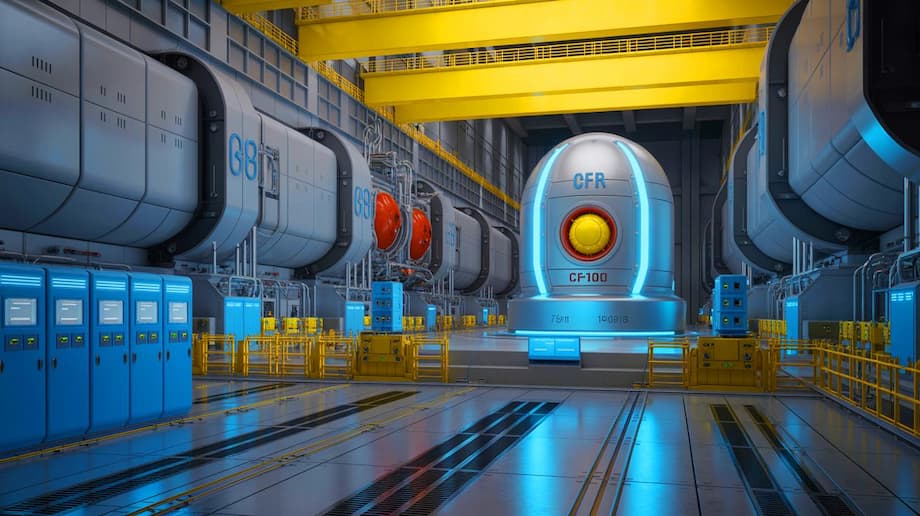China’s CFR-1000: The Next Leap in Nuclear Technology
China has taken a bold step into the future of nuclear energy with the unveiling of the CFR-1000, a fourth-generation fast neutron reactor designed to generate up to 1.2 gigawatts (GW) of electricity—enough to power about one million homes. This ambitious project, led by the China National Nuclear Corporation (CNNC), marks a significant milestone in China’s quest for energy security, technological leadership, and environmental sustainability. The CFR-1000 is not just a technical achievement; it is a development with far-reaching implications for global energy strategies, nuclear policy, and geopolitical power balances.
- China’s CFR-1000: The Next Leap in Nuclear Technology
- What Makes the CFR-1000 Different?
- China’s Fast Reactor Journey: From Experiment to Commercial Scale
- Strategic Importance: Energy Security and Sustainability
- Global Impact: Shifting the Balance of Power?
- Technical Challenges and Safety Considerations
- China’s Nuclear Fuel Cycle: Toward Self-Sufficiency
- International Collaboration and Competition
- Public Perception and the Future of Nuclear Energy
- In Summary
What Makes the CFR-1000 Different?
The CFR-1000 stands out from traditional nuclear reactors in several key ways. Most reactors worldwide use slow (thermal) neutrons and require moderators like water to sustain the nuclear chain reaction. In contrast, the CFR-1000 is a fast neutron reactor, meaning it uses high-speed neutrons and does not require a moderator. This fundamental difference brings several advantages:
- Higher Fuel Efficiency: Fast neutron reactors can extract more energy from nuclear fuel, making better use of resources.
- Reduced Nuclear Waste: They can burn long-lived radioactive waste, reducing the burden of nuclear waste management.
- Closed-Loop Fuel Cycle: The CFR-1000 can breed new fuel (such as plutonium-239) from non-fissile materials like uranium-238, potentially reducing the need for fresh uranium mining and supporting a sustainable, closed-loop fuel cycle.
Another notable feature is the use of liquid sodium as a coolant instead of water. Sodium transfers heat more efficiently and allows the reactor to operate at higher temperatures, boosting overall efficiency. However, sodium cooling also introduces new technical challenges, such as the risk of chemical reactions with air or water, which require careful engineering and operational management.
Fourth-Generation Nuclear Power: What Does It Mean?
The CFR-1000 is classified as a fourth-generation nuclear reactor. This term refers to a set of advanced nuclear technologies developed to address the limitations of earlier designs, particularly in terms of safety, sustainability, and waste reduction. Among the six reactor types recognized as fourth-generation, three are fast reactors: sodium-cooled, gas-cooled, and lead-cooled. Sodium-cooled fast reactors, like the CFR-1000, are considered the most mature and promising due to their operational experience and technical advantages.
China’s Fast Reactor Journey: From Experiment to Commercial Scale
China’s pursuit of fast reactor technology is not new. The journey began in 1964 with research and development on fast neutron reactors. The first major milestone was the China Experimental Fast Reactor (CEFR), a 20 megawatt electric (MWe) sodium-cooled fast reactor built with Russian assistance. The CEFR achieved grid connection in 2011 and has since operated as a research and demonstration facility, helping China master the fundamentals of fast reactor technology.
Building on this foundation, China launched the CFR-600 project—a 600 MWe demonstration fast reactor, with construction starting in 2017 in Xiapu County, Fujian Province. The CFR-600 is a stepping stone to commercial-scale deployment, and its successful operation has paved the way for the CFR-1000.
The CFR-1000 represents the third stage in China’s fast reactor roadmap: from experimental, to demonstration, to commercial application. According to CNNC, the preliminary design is now complete, and the project is awaiting regulatory approval. If all goes according to plan, the CFR-1000 could begin operation by 2034.
Strategic Importance: Energy Security and Sustainability
China’s rapid economic growth and urbanization have driven a relentless demand for energy. At the same time, the country faces mounting pressure to reduce carbon emissions and transition to cleaner energy sources. Nuclear power is a key component of China’s strategy to achieve its dual carbon targets—peaking emissions before 2030 and reaching carbon neutrality by 2060.
The CFR-1000’s ability to use spent fuel and breed new fuel from uranium-238 means it can help China reduce its reliance on imported uranium and make better use of existing nuclear materials. This aligns with China’s broader goal of self-sufficiency in the nuclear fuel cycle. According to the World Nuclear Association, China aims to produce one-third of its uranium domestically, obtain another third through foreign equity in mines, and purchase the remaining third on the open market. The CFR-1000’s closed-loop fuel cycle could further reduce dependence on foreign suppliers and enhance energy security.
Environmental and Economic Benefits
Fast neutron reactors like the CFR-1000 offer several environmental advantages. By burning long-lived radioactive waste and using spent fuel as feedstock, they can significantly reduce the volume and toxicity of nuclear waste requiring long-term storage. This addresses one of the most persistent public concerns about nuclear power.
Economically, the high efficiency and fuel utilization of fast reactors can lower the overall cost of nuclear energy in the long run. The ability to produce valuable isotopes and transmute waste into usable fuel adds further value. As Zhang Donghui, chief scientist at CNNC, explained at the recent symposium in Fuzhou:
Fast neutron reactors offer three main advantages: safety, as there are no credible scenarios leading to core meltdown and radioactive materials would be contained even in severe accidents; environmental benefits, as they can incinerate long-lived radioactive waste and have extremely low emissions; and economic viability, as they use spent fuel and waste materials as feedstock and can achieve better capital efficiency than existing reactors.
Global Impact: Shifting the Balance of Power?
The unveiling of the CFR-1000 has sparked intense debate and concern among international experts and policymakers. On one hand, the reactor is hailed as a technological triumph that could accelerate the global transition to cleaner, more sustainable energy. On the other, it raises questions about nuclear safety, proliferation risks, and the shifting balance of power in the global energy landscape.
Proliferation Concerns and International Scrutiny
One of the most controversial aspects of fast neutron reactors is their ability to produce plutonium-239, which can be used in nuclear weapons. While the primary purpose of the CFR-1000 is civilian power generation, the potential for dual-use technology has drawn scrutiny from nonproliferation experts. China’s use of Russian-supplied enriched uranium for earlier fast reactors, and ongoing cooperation with Russia on fuel supply and technology, adds another layer of complexity to the international response.
The Gen IV International Forum, a global alliance for nuclear research and development, promotes fast reactor technology as safer and cleaner in the long run. However, the forum also emphasizes the need for robust safeguards and transparency to prevent the diversion of nuclear materials for military purposes.
Geopolitical Implications
China’s progress with the CFR-1000 positions it as a leader in advanced nuclear technology, potentially outpacing other major nuclear powers. Russia currently operates the world’s largest sodium-cooled fast reactor, the BN-800, and is building the BN-1200, also with a 1.2 GW capacity. The United States, meanwhile, has no operating fast reactors but is developing the Natrium reactor (345 MW) through a partnership between TerraPower and the US Department of Energy.
The CFR-1000’s success could prompt other countries to accelerate their own fast reactor programs or reconsider their nuclear policies. As noted by Energy Reporters:
The international community is closely watching China’s progress, as this advancement could shift the balance of power in global energy and prompt other nations to reconsider their nuclear strategies.
Technical Challenges and Safety Considerations
While the CFR-1000 offers many advantages, it also presents significant technical and safety challenges. Sodium coolant, for example, is highly reactive with water and air, requiring meticulous engineering to prevent leaks and fires. The operational experience with sodium-cooled reactors worldwide—over 400 reactor-years—provides a foundation, but each new design must address unique risks.
China’s nuclear regulators will subject the CFR-1000 to rigorous safety assessments before granting approval. The reactor’s design incorporates multiple safety systems, including active and passive shutdown mechanisms and passive decay heat removal. These features are intended to prevent core meltdown and contain radioactive materials even in severe accident scenarios.
Learning from Global Experience
Globally, sodium-cooled fast reactors have a mixed track record. While Russia’s BN-series reactors have operated successfully, earlier projects in the United States, France, and Japan faced technical setbacks and public opposition. China’s approach—building on incremental experience from the CEFR and CFR-600—reflects a cautious but determined strategy to master the technology before scaling up to commercial deployment.
China’s Nuclear Fuel Cycle: Toward Self-Sufficiency
The CFR-1000 is a key component of China’s broader effort to achieve self-sufficiency in the nuclear fuel cycle. This includes domestic uranium mining, international partnerships for fuel supply, and the development of advanced reprocessing and waste management technologies. China is investing heavily in R&D on high-temperature gas-cooled reactors, molten salt reactors, and accelerator-driven systems, in addition to fast neutron reactors.
According to the World Nuclear Association, China’s uranium demand is expected to rise sharply as its nuclear fleet expands—from over 11,000 tonnes in 2023 to more than 40,000 tonnes by 2040. The ability to recycle fuel and close the fuel cycle with fast reactors like the CFR-1000 will be crucial for meeting this demand sustainably.
International Collaboration and Competition
China’s fast reactor program has benefited from international collaboration, particularly with Russia, which supplied technology and fuel for the CEFR and CFR-600. However, China is increasingly focused on developing indigenous capabilities and reducing reliance on foreign suppliers. The country has established a comprehensive industrial chain for fast reactors, including design, manufacturing, construction, and project management.
At the same time, China is participating in international forums and nonproliferation agreements to demonstrate its commitment to safe and responsible nuclear development. The CFR-1000’s progress will be closely monitored by global stakeholders, including governments, industry, and environmental groups.
Public Perception and the Future of Nuclear Energy
The CFR-1000 comes at a time when public attitudes toward nuclear power are shifting. Concerns about climate change and the limitations of renewable energy sources have led some countries to reconsider nuclear energy as a low-carbon option. However, safety fears and the legacy of past nuclear accidents continue to influence public opinion.
China’s ability to demonstrate the safety, reliability, and environmental benefits of the CFR-1000 will be critical for building public trust and securing support for future projects. The reactor’s performance could serve as a benchmark for nuclear innovation worldwide, shaping research, investment, and policy decisions for decades to come.
In Summary
- The CFR-1000 is China’s first commercial-scale, fourth-generation fast neutron reactor, designed to generate 1.2 GW of electricity.
- It uses fast neutrons and liquid sodium coolant for higher efficiency, reduced waste, and the potential for a closed-loop fuel cycle.
- The reactor is a cornerstone of China’s strategy for energy security, sustainability, and technological leadership.
- International experts are watching closely due to safety, proliferation, and geopolitical concerns.
- The CFR-1000 is expected to begin operation by 2034, pending regulatory approval, and could influence global nuclear policy and innovation.
- China’s progress in fast reactor technology reflects decades of research, international collaboration, and a commitment to self-sufficiency in the nuclear fuel cycle.
- The success or failure of the CFR-1000 will have lasting implications for the future of nuclear energy and the global balance of power.




